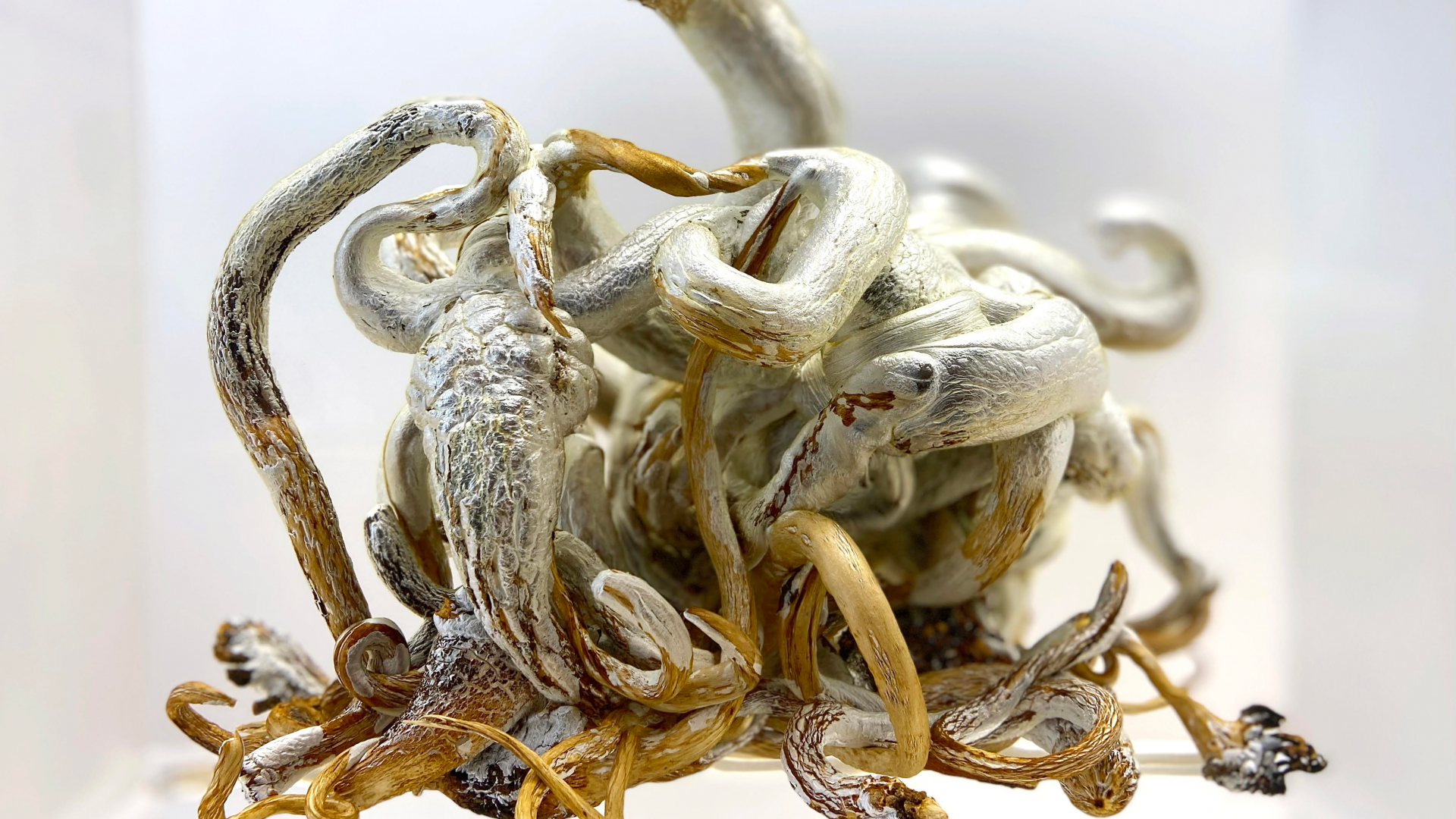In the south-westernmost corner of Germany, where the Rhine curves round marking the border with Switzerland and then France, the historic town of Staufen im Breisgau perches on the edge of the Schwarzwald (Black Forest).
At the heart of a wine-growing landscape of rolling hills, in the region that statistically enjoys more sunshine per year than any other part of Germany, Staufen attracts many who wish to explore the hiking routes up into the surrounding mountains, and is also well-placed for those who wish to visit the area’s thermal baths and wellness resorts. It has a rich history dating back before the Romans.
Yet although many picturesque towns across Europe commemorate noteworthy citizens in statues and memorials, few others are likely to have done so with a large public mural depicting their most famous former resident being carried off to hell by a winged devil. In addition to strange tales from its past, there are also disturbing undercurrents lurking in the very earth beneath its streets.
Approaching Staufen from any direction, the eye is drawn to its ruined 12th-century hill castle commanding the area, evidence of the settlement’s former strategic importance. In continuous use for half a millennium, the fortification was burned down in 1632 by occupying Swedish troops during the thirty years’ war.
Today, its steep surrounding slopes are home to the vineyards of a family firm who have been producing wine in Staufen for the past three centuries. On the outskirts, the visitor is then greeted by signs that say “Fauststadt Staufen” – proclaiming the town’s links to the central figure in one of the most important works of German literature, Goethe’s Faust.
A short walk through the town’s historic medieval centre only reinforces that connection: there’s the Faust Apotheke chemist’s shop, established 1778; a bookshop called the Goethe Buchhandlung; a clothing store named Faust & Gretel after the characters in the play; a Hotel Goethe whose breakfast room is hung with portraits of the writer; and a theatre named Auerbachs Kellertheater in honour of the Leipzig tavern to which Mephistopheles takes Faust.
Around 900 pupils attend the town’s main school, the Faust-Gymnasium, while shops on the high street offer postcards of Faust selling his soul, adorned with the slogan “Staufen tut teuflisch gut!” (“Staufen feels devilishly good!”), which can then be written at an alfresco table of Weingut Peter Landmann while enjoying a glass of their sparkling Doktor Faustus sekt.
Although Goethe himself was born in Frankfurt am Main, nearly 300km to the north, and lived for much of his life a further 250km to the east in Weimar, the explanation for Staufen’s focus on his most famous literary character can be found in a painting that dominates the outside wall of the Gasthaus zum Löwen, an early 16th-century building on the market square, somewhat imaginatively portraying the demise of the real-life Faust in the year 1540, upstairs in what is now room 5 of the hotel.
The man around whom so many conflicting stories began circulating even during his lifetime was apparently born Johann Georg Faust in 1480 in the small town of Knittlingen, near Stuttgart. He acquired a reputation in some quarters as a confidence man, while a teacher who happened to observe the younger Faust in a bar described him in a letter to a friend as a loudmouth and a shifty, untrustworthy character.
Moving from place to place within Germany, Faust worked briefly for abbots, bishops or noblemen who employed him to cast horoscopes or conduct alchemical experiments in an attempt to produce gold. His death at the Gasthaus zum Löwen may well have been the result of an explosion caused by such a procedure, conducted on behalf of the current lord, Hans Ludwig von Staufen, whose ancestor Adalbert built the castle.
What today might simply be classed as an industrial accident soon gave rise to a wealth of rumours and fables centred around Faust’s supposed pact with the devil, many of which were collected in a chapbook printed in Frankfurt in 1587, Historia von D Johann Fausten, commonly known as the Faust Book, which proved enough of a success that a translation was published in England five years later. This became a key source and inspiration for Marlowe’s The Tragical History of the Life and Death of Doctor Faustus, which premiered the same year, and a century later for Goethe’s Faust.
As the tale spread across Europe during the 17th and 18th centuries, Faust’s character also appeared in a variety of languages in numerous plays, ballets, pantomimes and farces. Somewhere among the roots of it all, traces of the real person may have been lurking, but as James Stewart’s character is told by a newspaper editor in John Ford’s film, The Man Who Shot Liberty Valance, “When the legend becomes fact, print the legend”.
Faust brought about his own destruction by unleashing forces beyond his control, and present-day visitors to Staufen looking up at the picture of him on the building where he met his end will also see a network of severe cracks running up its walls. These, however, are not evidence of that final explosive confrontation, but a far more recent series of events, and similar damage can be seen in many other late-medieval houses throughout the town. Imitation giant sticking plasters have been pasted across some of the cracks, bearing the slogan “Staufen darf nicht zerbrechen!” (“Staufen must not be allowed to break!”), a campaign which has been running for almost two decades.
Staufen’s problem dates back to an attempt in 2007 to harness some of the same natural below-ground energy that has long made the region a centre of health spas and thereby provides a green source of heating and cooling for the 16th-century Rathaus (town hall). When seven geothermal probes were driven down to a depth of 140 metres in the lane directly behind the building, it went disastrously wrong, causing water ingress into a gypsum keuper layer, which then began to swell, and continues to do so.
Within a month, the ground under the town hall and the surrounding area was rising by 11 centimetres a month, and the buildings began to crack. Some residents lay awake at night listening to the disturbing noises as their homes began to slowly shift and fracture.
Eventually, 268 houses reported problems, and during those first months, it was not known whether the centre of the city would have to be evacuated. The boreholes themselves were sealed in 2009, and a system to pump out groundwater was installed.
Over time, this has greatly reduced the basic problem, but as of last year the ground was still rising by one millimetre a month, and until things have stabilised, fundamental renovations to Staufen’s affected buildings can not begin.
All of which might sound relatively apocalyptic, yet walking through Staufen today on a bright early-summer morning, the town looks and feels like a very fine place to be. There is locally produced fresh fruit, vegetables and honey available at the twice-weekly market that was established here on the market square around the year 1300; open-air swimming at the beautifully restored late 19th-century Allemannenbad; the narrow water channels, known as Bächle, running along either side of the pedestrianised Hauptstraße, in which people cool their feet on a hot day while watching the parade of passers-by.
An absence of chain stores and generic fast-food outlets combined with the harmonious decoration and historically appropriate colour schemes of the houses give the town a distinctive charm. At every turn, glimpses open up between the rooftops of the mountains of the high Schwarzwald rearing up immediately to the east, and the seemingly unbroken line of the peaks of the Vosges mountains to the west, just across the border in France.
The cracks may still be there, but the mood is positive, and Staufen remains a very popular tourist destination. After all, it has seen off other existential threats in the past.
Owing to its key strategic position in these borderlands, the town was invaded and looted multiple times, and during the 17th and 18th centuries the population was in the habit of regularly taking shelter in the surrounding forests, sometimes for months on end as yet another group of enemy troops or mercenaries ransacked the town. At such times, packs of wolves could be seen roaming the empty streets at night, encouraged by the absence of people.
Then, in 1848, when uprisings broke out across Europe, 2,000 revolutionaries led by Gustav Struve and his wife Amelie occupied Staufen as part of the Badische Revolt. They were attacked in turn by 800 heavily armed soldiers who retook the town in just two hours, killing 17 locals in the process.
One man who escaped was the landlord of the Gasthaus Krone on the Hauptstraße, still open for business today. It too has a mural on its outside wall, commemorating that occasion, which shows him facing down a party of troops with the words “Ich duld es nicht, dass ich erschossen werde!” (“I will not tolerate being shot”). Taken aback, they spared his life.
Today, such dangerous confrontations seem far away, and you can sit on the 19th-century bridge over the River Neumagen at one of the tables of Café Decker enjoying a slice of Schwarzwälder Kirschtorte at the very spot where in 1848 the troops overcame the rebel barricades and gained entry to the town. Within sight of that bridge, construction is now nearing completion on a 4,000 square-metre multi-purpose cultural events hall and library, funded by both the municipal authority and the state of Baden-Württemberg, due for completion by the end of this year.
Its name? The Faust Forum.
Max Décharné is an English rock musician and singer, and the author of 10 books, mostly non-fiction



